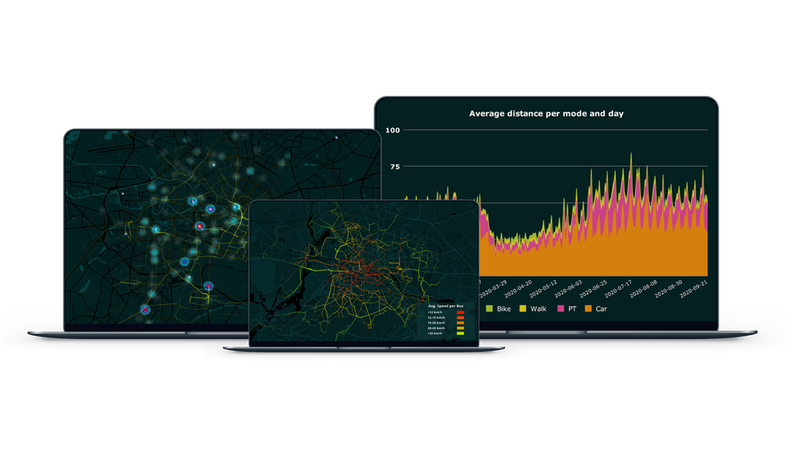All images: Max Bögl
SkedGo CEO John Nuutinen. Credit: Skedgo


MOTIONTAG managing director Fabien Sauthier. Credit: MOTIONTAG
Q&A | Technology
The MaaS effect: will future travel be on demand?
Andrew Tunnicliffe speaks with SkedGo CEO John Nuutinen and MOTIONTAG managing director Fabien Sauthier about Mobility-as-a-Service (MaaS) and how it can facilitate better transport options.
If there’s one thing the majority of us have done at least once in recent months, it has been accessing something on demand. The convenience of such services has always been obvious, but their appeal probably never more so than right now.
Mobility-as-a-Service (MaaS) is another form of on demand that will fundamentally alter the way we move in years to come. Bringing an integrated transportation network to the travelling public has long been the goal.
A recent partnership between two tech providers will, they say, offer an “enriched user experience” whilst capturing all the data needed to plan future infrastructure and services – all via an app. Ultimately, the aim is to deliver an on-demand concept to the world’s transport networks.
SkedGo already enables users to plan, book and pay for multimodal, preference-based, door-to-door trip itineraries. It will now integrate with MOTIONTAG’s behavioural nudging and analytical diagnostics capabilities, allowing customers to initiate, benchmark and validate the modal shift users and identify how, when and where people actually move.
SkedGo CEO John Nuutinen. Credit: Skedgo


MOTIONTAG managing director Fabien Sauthier. Credit: MOTIONTAG
Andrew Tunnicliffe: How does the app work and what information can it provide stakeholders?
John Nuutinen (JN): The SkedGo branded white-label solution (a product that can be rebranded to the client’s needs) enables clients to provide their users access to multi and mixed modal transport options and trip itineraries via a simple user interface.
SkedGo configures the experience by integrating local transport service providers into the solution and producing the trip itineraries according to the preference of the user. For example, users can choose to reduce their carbon emissions, cost of travel or time to destination.
The MOTIONTAG integration will further consolidate the user’s behavioural change and mode shift by utilising machine learning to surface “better” transport options based on the user’s goals or objectives.
It does this by comparing how the user has, and is, travelling and then nudging them towards optimised future travel scenarios. Incentives can be initiated to reinforce the “good” behavioural shift. The rich data and analytics produced by MOTIONTAG enable the host to benchmark and validate the user’s behavioural shift.
When things did start to pick up, when the lockdown was relaxed, the trains were fantastic

Credit: SkedGo | MOTIONTAG
How will this information help you and travellers make future decisions and how is this different to previous tools?
JN: This integration will enable the host of a SkedGo branded white-label solution to better understand their user’s behaviour.
The data produced will identify what the user’s travel preferences are; analysis of this data will provide a comparative benchmark between actual behaviour and preferred behaviour. The host now has the tools to introduce behavioural nudging by providing incentives and consolidating the shift.
How will you work with other stakeholders to develop a more intuitive and personalised transport network?
JN: We are currently developing situational and contextual trip planning capabilities. This will further customise trip planning by supplementing preference-based itineraries with the situation and context of the user. For example, weather, reduced mobility or circumstantial trip itineraries will be further personalised with the adoption of machine learning and AI.
Fabien Sauthier (FS): Other services, such as personalised recommendations to users for their most used routines, are a perfect example of how users could directly benefit from the combination of SkedGo’s trip planning APIs and our transport mode detection capabilities.
Are there any concerns about the use of personal data and if not, how have you achieved this?
JN: We are both GDPR (General Data Protection Regulation) compliant. Data collected and analysed is anonymised and aggregated to ensure that privacy is maintained. Of course, with some solutions, users can opt-in.
How might this technology assist in a world where Covid-19 may be with us for many years?
JN: We already provides users with the ability to prioritise trip itineraries which are Covid-19 and crowd aware. This functionality enables users to plan trips which avoid Covid hotspots and use transport modes that are less crowded.
For example, in Sydney the TripGo app will indicate which train carriages are less busy and in Melbourne the Department of Transport is about to provide data on the crowdedness of train platforms.
With the access to enriched data we will see the introduction of complex and powerful applications which can assist in the prevention of the further spreading of Covid.
FS: We are already helping the Swiss and German governments better understand how people’s travelling behaviours are changing due to Covid. We want our data to be used for the greater good, and crowdsourcing that type of data today is a great asset.
How important is it to identify changing passenger trends?
JN: MaaS has been validated. However, there are two challenges that remain: to demonstrate the financial viability of the MaaS model and effective behavioural change; the two are linked.
The inability to change user behaviour will have a direct impact on the commercial viability of MaaS models. Behavioural change will facilitate the introduction of new commercial models, sustain the momentum behind carbon reduction and influence the future of all transport options. The inability to measure and prove behavioural change will delay the wholesale adoption of MaaS.
FS: It’s crucial to understand the demand side of the mobility equation as transport providers need to match this with their supply. The successful arrival of new actors in the mobility space, such as ride-hailing and other sharing solutions, has proven that some needs were not met by public transport.
The point now is to provide the right transport solution to the right person and at the right time. MaaS is the framework that can achieve this at scale, with public transport at its core.
Aside from the benefits it may bring travellers, are there concerns among stakeholders this technology may inadvertently push passengers away from their transport solution?
JN: A disruptive influence like MaaS will challenge some more than others. However, commuters were already on the journey to modal shifts.
With the introduction of MaaS we will see broader adoption of a greater variety of transport modes. To date we have not witnessed a wholesale shift away from private vehicles, but we have experienced a greater incidence of mixed or multimodal travel.
MaaS, as a commuting solution, is encouraging the user to trial and adopt new and different modes, but this adoption is not replacing another existing mode entirely. The trip chains that make up a trip itinerary still rely on all transport options and this interconnectivity delivers more benefits and good than being a threat to Individual stakeholders.
FS: With 25% of CO2 coming from the mobility sector, the stakes are massive and we need to act now. All mobility stakeholders are aware of this, so it’s only natural that the transportation offer changes.
We want to accelerate this transition in two ways. First by enabling individual travellers to better understand their CO2 emissions, incentivise behavioural change and foster it in the long term.
Second, only infrastructure change will have a long-term impact: providing better multimodal data to transport planners and smart city stakeholders is the key to enabling this long-term change.
What do you see the mid to long-term challenges are for transport stakeholders and how should they prepare?
JN: Data is the lifeblood of MaaS. Without access to compatible, standardised, high-quality data the system will struggle to live up to expectations. To participate and thrive in MaaS, transport stakeholders need to digitise and invest into the data that they consume and aggregate.
FS: We need to change the way we think about mobility; it’s not about car versus bike versus walking. Transport models are outdated as the current methods of identifying transport modes are unimodal and usually car-centred.
We are seeing citizens and politicians wanting to change this and put the human at the centre of the equation, so times are changing. The key to doing this properly and cost effectively is by using multimodal transportation data. This is the key to doing changes that reflect properly the travel demands of citizens.